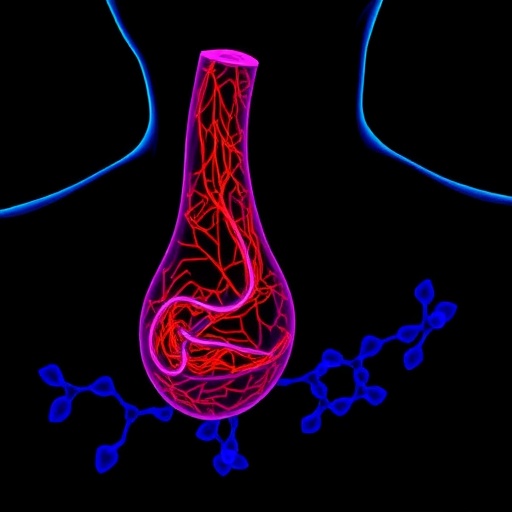In the relentless pursuit of enhancing cancer prognostics, a groundbreaking study published in BMC Cancer has unveiled an innovative model centered on basement membrane-related regulators to predict esophageal cancer outcomes with remarkable precision. This advance not only charts new territory in the molecular understanding of esophageal carcinoma but also bridges computational analyses with experimental validation, promising transformative implications for clinical oncology.
Esophageal cancer remains one of the most lethal malignancies worldwide, owing largely to its late diagnosis and aggressive metastatic behavior. Central to cancer metastasis is the basement membrane, a specialized extracellular matrix layer instrumental in maintaining tissue architecture and influencing cellular behavior. While prior research has highlighted its general importance, the exact molecular constituents and their prognostic utility in esophageal carcinoma have remained elusive—until now.
The investigative team embarked on a comprehensive analysis incorporating 152 esophageal cancer specimens alongside 11 normal esophageal tissue samples. Employing cutting-edge differential gene expression profiling and state-of-the-art statistical techniques such as Least Absolute Shrinkage and Selection Operator (LASSO) regression, they distilled a robust six-gene signature tightly linked to basement membrane components. These genes—LAMC2, GPC2, AGRN, ITGA3, LAMA3, and LOXL4—emerged as potent prognostic markers, each contributing uniquely to tumor progression dynamics.
To translate these molecular insights into clinically actionable tools, researchers integrated the six-gene panel with traditional clinical parameters via a nomogram—a graphical calculation tool widely used in medical prognosis. This fusion enabled a personalized risk stratification framework capable of predicting overall survival rates with enhanced accuracy. Such integration underscores a pivotal shift toward multi-dimensional prognostic models in oncology, where molecular signatures complement clinical observations.
Delving deeper, the team harnessed bioinformatic algorithms to profile the tumor microenvironment’s immune landscape across varying risk categories determined by the gene panel. Notably, distinct patterns of immune cell infiltration were observed between high-risk and low-risk patient groups, illuminating the interplay between basement membrane alterations and immune modulatory mechanisms within the esophageal tumor niche. These findings pave the way for exploring immune-targeted therapies tailored according to basement membrane gene expression patterns.
Parallel to immune profiling, analyses of chemotherapeutic sensitivity underscored differential drug responsiveness in stratified risk groups. This revelation promises to refine therapeutic regimens by aligning treatment modalities with molecularly defined patient subsets, potentially mitigating the high attrition rates in conventional chemotherapy outcomes for esophageal cancer.
Crucially, the study transcended in silico predictions through rigorous experimental validation. Immunohistochemical assays confirmed pronounced overexpression of the identified six genes within esophageal tumor tissues, strengthening their candidacy as biomarker targets in clinical practice. Such protein-level validation is indispensable for bridging the gap between genomic findings and tangible medical applications.
Further mechanistic exploration utilized KYSE-150 esophageal squamous carcinoma cell lines to dissect the functional roles of each gene. Gene silencing experiments revealed a nuanced architecture of tumor cell behavior: knockdown of LAMC2 significantly impeded cellular migration, indicative of its pro-metastatic influence. Conversely, suppression of AGRN, GPC2, ITGA3, LAMA3, and LOXL4 paradoxically enhanced migratory capacity, suggesting complex regulatory feedback within the tumor microenvironment.
Complementary proliferation assays illuminated additional layers of gene functionality, with inhibition of GPC2, ITGA3, and LAMA3 leading to accelerated cancer cell growth. These observations intimate that these basement membrane genes not only orchestrate metastatic potential but also modulate proliferative vigor, thereby dictating tumor aggressiveness through multifaceted molecular pathways.
The synthesis of computational modeling, clinical correlation, and laboratory experimentation culminated in the establishment of a basement membrane-derived risk signature—a novel prognostic apparatus poised to revolutionize esophageal cancer management. By finely categorizing patients according to molecular risk, this model empowers clinicians to craft individualized surveillance and treatment protocols, optimizing therapeutic efficacy.
Beyond prognostication, this research illuminates prospective molecular targets for drug development. Modulating the expression or activity of these six basement membrane-related genes could yield innovative therapeutic avenues, potentially curbing tumor dissemination and improving survival rates in esophageal cancer patients.
This work exemplifies the synergy of integrative omics and functional biology, spotlighting how basement membrane dynamics are inextricably linked with tumor progression. The elucidation of these intricate gene networks enhances our understanding of esophageal cancer biology and fosters precision medicine paradigms customized to molecular tumor profiles.
Future investigations may expand upon these findings by exploring the interplay of basement membrane regulators with other tumor microenvironmental factors, including stromal cells and signaling cascades. Such holistic comprehension could refine prognostic accuracy and unearth new intervention strategies that transcend current therapeutic limitations.
In essence, this model heralds a new era in esophageal oncology research, where basement membrane constituents serve as both prognostic sentinels and therapeutic targets. Its clinical translation could transform patient care, enabling earlier intervention and bespoke treatments that markedly improve outcomes against this formidable disease.
As esophageal cancer continues to challenge the medical community, the integration of biomarker-driven risk modeling and functional validation paves a promising path forward. The collective efforts by Xu, Wang, and their colleagues mark a significant leap toward unraveling the molecular complexity of esophageal carcinoma and tailoring its management with unprecedented precision.
The study’s comprehensive approach—merging bioinformatics, immune profiling, drug sensitivity analyses, and cellular biology—provides a robust framework encouraging similar multidimensional investigations across other aggressive cancers. Such endeavors will likely accelerate the advent of next-generation diagnostic and therapeutic tools, marking milestones in oncology’s battle against metastatic disease.
In conclusion, this innovative basement membrane-related gene signature not only enhances prognostic capabilities but also enriches the understanding of esophageal cancer’s molecular underpinnings. It stands as a testament to the power of integrated research strategies in combating cancer and offers tangible hope for affected patients worldwide.
Subject of Research: Basement membrane-related regulators as prognostic biomarkers and functional modulators in esophageal cancer.
Article Title: A model of basement membrane-related regulators for prediction of prognoses in esophageal cancer and verification in vitro.
Article References:
Xu, L., Wang, B., Wang, C. et al. A model of basement membrane-related regulators for prediction of prognoses in esophageal cancer and verification in vitro. BMC Cancer 25, 696 (2025). https://doi.org/10.1186/s12885-025-14081-4
Image Credits: Scienmag.com




